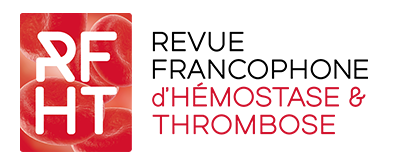RÉSUMÉ
L’histoire de l’anticoagulation a considérablement évolué, passant de médicaments non spécifiques (les héparines et les antivitamines K) à des molécules qui ciblent directement des facteurs de coagulation spécifiques (l’argatroban, le fondaparinux et les anticoagulants oraux directs, AOD). Au cours des dix dernières années, les AOD se sont imposés dans l’arsenal thérapeutique grâce à leur facilité d’administration, leur profil pharmacologique favorable et du fait qu’ils ne nécessitent pas de surveillance biologique. De nouveaux anticoagulants ciblant la phase de contact de la coagulation sont actuellement en développement et pourraient permettre de prévenir le risque thrombotique sans altérer l’hémostase physiologique, réduisant ainsi le risque hémorragique. Le facteur XII (FXII) semble être alors une cible intéressante et son inhibition permettrait de limiter la thromboformation, mais aussi l’inflammation, sans majorer la survenue d’hémorragie. L’objectif de cet article est de résumer les informations principales concernant les inhibiteurs du FXII et de passer en revue les résultats des différents essais cliniques disponibles à ce jour.
MOTS CLÉS
angiooedème, facteur XII, inflammation, phase contact, thrombose
ABSTRACT
The history of anticoagulation has evolved considerably, from non-specific drugs (heparins and antivitamin K) to molecules that directly target specific coagulation factors (argatroban, fondaparinux and direct oral anticoagulants, DOACs). Over the last ten years, DOAC have been widely used in clinical practice because of their ease to use, their favorable pharmacological profile and the fact that they do not require monitoring. New anticoagulants targeting the contact phase of coagulation are currently under development, and could make it possible to prevent thrombotic risk without altering hemostasis, thereby reducing the risk of bleeding. FXII appears to be an interesting target, and its inhibition could decrease thrombosis, as well as inflammation, without increasing the occurrence of bleeding. The aim of this article is to summarize the main data concerning FXII inhibitors, and to review the results of the various clinical trials available to date.
KEYWORDS
angioedema, contact phase, FXII, inflammation, thrombosis

